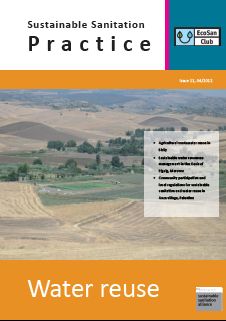
Published in: 2012
Publisher:
Sustainable Sanitation Practice (SSP), Issue 11. EcoSan Club, Austria
Author:
Ecosan Club (ed.)
Uploaded by:
SuSanA secretariat
Partner profile:
EcoSan Club
6575 Views
114 Downloads
Location of library entry
Content - Summary
With rapidly growing demand for food and energy on the one hand and continuing urbanisation on the other hand, stress on water resources is steadily increasing. Therefore, reuse and recycling of water will inevitable play a leading part when it comes to sustainable development. Already today most of the world’s freshwater recourses are used in agriculture, mostly for food production.
To meet the challenges extremely efficient water use is necessary to achieve overall improvements in water productivity. Multi-use systems will therefore be crucial in integrated water management. Different examples show how water can be reused and recycled and thus increasing water efficiency in urban, peri-urban and rural areas.
Issue 11 of Sustainable Sanitation Practice (SSP) on „Water reuse“ shows 3 examples for the use of treated wastewater for irrigation in agriculture:
• The first paper presents results from a long-term study carried out in Sicily, Italy.
Barbagallo, S., Cirelli, G. L., Consoli, S., Licciardello, F., Marzo, A., Milani, M., Toscano, A.
In Mediterranean countries, water shortage is becoming a problem of high concern affecting the local economy, mostly
based on agriculture. In addition, often the problem is not only the scarcity of water in terms of average per capita,
but the high cost to make water available at the right place, at the right time with the required quality. In these cases,
an integrated approach for water resources management including wastewater is required. The management should
also include wastewater reclamation and reuse, especially for agricultural irrigation. This study evaluates and compares
the efficiency of two full-scale Horizontal SubSurface Flow Constructed Wetlands (H-SSF CWs), located in Southern
Italy (Sicily), both in terms of water quality improvement (removal percentage) and achievement of Italian wastewater
discharge and irrigation reuse limits. Moreover, the impact on tomato crops of drip and sub-drip irrigation with treated
municipal wastewater, as well as effects of wastewater reuse on main production features, microbial soil and products
contamination were investigated. The analysis of the reuse scenario confirms that, under controlled conditions,
low-quality wastewater can be used to increase tomato crops production in water-scarce Mediterranean environments.
++++++++
• The second paper presents activities on water management in the Oasis of Figuig, Morocco.
Torrens, A., Alcalde, L., Folch, M., Salgot, Casanova,P., Queralt, E., Elhachemi, O., Elhalouanih, H., González, C.
In the Oasis of Figuig, Morocco, a sustainable management of the water resources
in the Oasis shall be implemented that is focusing in the rational use of water in
agriculture and wastewater reuse. This paper presents the activities carried out in
the Oasis within the Project “Support to the public policy of water management in
Figuig”.
++++++++
• The third paper presents practical experiences from a feasibility study on technology selection for wastewater treatment and effluent reuse schemes in Anza village, Palestine.
Al-Sa`ed, R., Abdellatif, M., Lechner, M.
Free access to water and agricultural land, and sustainable sanitation can reduce food insecurity and enhance
economic development in Palestine. This paper presents initial findings of an EU funded project to erect
sustainable wastewater treatment and effluent recycling schemes for food security in Anza village. The project
aimed at the erection of affordable and environmentally sound sanitation infrastructures considering community
consultation and local regulatory rules. The feasibility study showed that low cost treatment options were
neither sustainable nor cost effective compared with mechanised biological systems. Results of scoping sessions
revealed that major stakeholders (village council members, women and farmers) are willing to accept and pay for
environmentally sound and cost effective sanitation facilities. The study recommends the need for coordination
between regulatory institutions, funding agencies and community to oversee and coordinate planning activities.
Early community participation in the planning process facilitated proper technology selection considering the
socio-political, financial and environmental aspects.
Bibliographic information
Ecosan Club (ed.) (2012). Water reuse. Sustainable Sanitation Practice (SSP), Issue 11. EcoSan Club, Austria
Filter tags
Constructed wetlands English Europe & Central Asia Greywater or wastewater Middle East & North Africa Urban (entire city)















